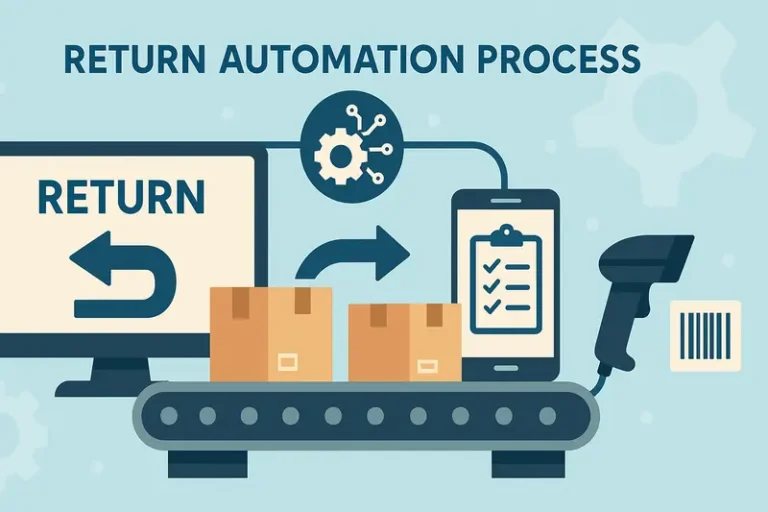Ecommerce Returns Best Practices: How to Streamline Processes and Boost Customer Satisfaction

Last updated on April 30, 2025

In this article
 9 minutes
9 minutes
- Key Takeaways
- Importance of Effective Ecommerce Returns Management
- Crafting a Clear and Transparent Return Policy
- Offering Free Return Shipping: When and Why
- Automating the Returns Process
- Integrating Inventory Management Systems
- Utilizing Data Analytics for Actionable Insights
- Encouraging Product Exchanges Over Refunds
- Managing Returns During Peak Seasons
- Hidden Costs of Poor Returns Management
- Best Practices for Efficient Returns Processing
- Summary
- Frequently Asked Questions
Struggling with high return rates? Discover the ecommerce returns best practices for managing returns efficiently. This article will help you streamline your return processes, enhance customer satisfaction, and boost your bottom line.
Key Takeaways
- Effective returns management is essential for customer satisfaction, impacting brand loyalty and profitability.
- A clear and transparent return policy builds trust with customers, reducing misunderstandings and enhancing their experience.
- Automation of the returns process improves efficiency and communication, leading to faster processing and higher customer satisfaction.
Importance of Effective Ecommerce Returns Management
Effective ecommerce returns management is a pillar of maintaining customer satisfaction. With return rates averaging nearly a quarter of all ecommerce purchases, the average ecommerce return rate is crucial for maintaining a positive brand perception and customer loyalty among ecommerce brands. An efficient ecommerce return process can significantly enhance the overall shopping experience.
Automation can play a significant role in this process. Automation of labor-intensive tasks improves efficiency and reduces operational costs. This results in fewer manual interventions, faster processing times, and ultimately, happier customers.
Quickly restocking returned products ensures optimal inventory levels, preventing revenue loss due to stockouts. An efficient returns management system makes this process seamless, contributing to higher profitability and creating a competitive advantage in the market.
In essence, effective ecommerce returns management enhances the overall customer experience, boosts customer satisfaction, and ensures managing ecommerce returns effectively long-term profitability.
Make Returns Profitable, Yes!
Cut shipping and processing costs by 70% with our patented peer-to-peer returns solution. 4x faster than traditional returns.
See How It WorksCrafting a Clear and Transparent Return Policy
A clear and transparent return policy is crucial for a positive returns experience. Research shows that approximately 60% of customers check the returns policy before making a purchase. A straightforward return policy builds trust and sets clear expectations, significantly boosting customer satisfaction.
Your return policy should be prominently displayed on your ecommerce website and included in the product page packaging for better visibility. This ensures that customers are aware of their options and reduces the likelihood of misunderstandings, which can lead to customer irritation.
Automated notifications and transparent communication throughout the customer returns process keep customers informed at every step, fostering trust and reducing friction. Clear instructions on how to return products further enhance hassle-free returns and customer experience.
A well-crafted return policy can protect your business against excessive returns and enhance your brand reputation. Clearly stating return timeframes and requirements sets customer expectations and reduces return-related customer service inquiries.
Offering Free Return Shipping: When and Why
Free return shipping can be a game-changer for ecommerce businesses, as customers are 62% more likely to engage in online shopping with brands that offer free shipping. This not only boosts customer satisfaction but also encourages larger purchases, especially when free ecommerce returns and free customer returns are available.
However, free returns come with challenges such as the costs associated with shipping labels, warehouse staff, and other labor expenses. Evaluate whether your profit margins can sustain these return costs before implementing a free returns policy.
Communicate your return shipping policy clearly. State your return shipping policy clearly in product listings, FAQs, and shipping policy pages to ensure customers are aware of their options. This transparency helps manage customer expectations and reduces potential conflicts.
Simplify the return process by providing prepaid return shipping labels and a return label through scannable, pre-printed, and printable options. Collection points, as an alternative for customers without physical store options, can save money compared to individual shipping.
Automating the Returns Process
Automation is revolutionizing the ecommerce returns process. Technology streamlines various aspects of returns, enhancing efficiency and customer satisfaction. Automated systems reduce manual staff intervention, lower operational costs, and speed up return handling time.
A key benefit of automation is the automatic creation of return labels. This saves time and reduces human error. Real-time tracking updates from automation systems provide customers with immediate information on return statuses, enhancing their experience.
Automated returns processes improve customer communication. Systems can send automated emails about return status and integrate with chatbots for inquiries, keeping customers informed at every step. This transparency and efficiency can significantly improve customer satisfaction.
Software like Loop can further enhance the process by automating the approval or denial of refund requests based on returns data. This reduces the workload on customer support teams and ensures a smoother, faster returns process.
Integrating Inventory Management Systems
Integrating inventory management systems with returns platforms ensures efficient returns processing. Stock levels are adjusted immediately when items are returned, preventing errors and maintaining accurate inventory data.
Real-time inventory updates minimize stock discrepancies and enhance operational efficiency. This level of accuracy helps businesses maintain balanced stock levels, which is vital for customer satisfaction and profitability.
Efficient restocking of returned items is crucial. Quickly reintegrating returned products into inventory maintains inventory flow and minimizes losses on unsold products.
A unified inventory management approach optimizes stock levels and ensures popular items are always available, enhancing the customer experience.
Convert Returns Into New Sales and Profits
Our peer-to-peer returns system instantly resells returned items—no warehouse processing, and get paid before you refund.
I'm Interested in Peer-to-Peer ReturnsUtilizing Data Analytics for Actionable Insights
Data analytics greatly improve ecommerce returns management. Analyzing returns data provides valuable insights into return trends, allowing businesses to make informed policy adjustments. Returns data analysis can identify inefficiencies, helping businesses enhance operational efficiency and reduce return rates. Returns data can reveal quality issues, allowing retailers to improve product descriptions and sizing, ultimately lowering return rates.
Understanding return trends enables businesses to adjust stock levels based on return patterns, optimizing inventory management. This proactive approach maintains balanced stock levels and minimizes costs.
Analyzing the timing of returns helps businesses anticipate peak return periods and better manage logistics. Refining exchange strategies through data analytics can further enhance customer satisfaction and retention.
Encouraging Product Exchanges Over Refunds
Promoting product exchanges over refunds can greatly benefit brick-and-mortar stores and ecommerce businesses. This strategy encourages customer retention and can attract loyal customers, potentially boosting sales in the post-purchase experience. Offering store credit can also enhance customer satisfaction.
Here are some key benefits of promoting exchanges:
- Retaining up to 50% of revenue through exchanges enhances customer retention and lifetime value.
- Offering free shipping and exclusive discounts on exchanges makes this option more appealing compared to refunds.
- A rewards program that gives points for exchanges can further enhance customer loyalty.
Making exchanges the default option during the return process can significantly increase exchange rates. Tailored product recommendations based on customer data can guide customers toward exchanges, enhancing their shopping experience. Extending the timeframe for exchanges and providing immediate store credit can give customers more flexibility and encourage continued shopping without waiting for returns to be processed.
Managing Returns During Peak Seasons
Managing returns during peak seasons is particularly challenging for ecommerce businesses. Return volumes can spike significantly, with some businesses experiencing rates as high as 30%. Forecasting return volumes based on past data allows for effective resource allocation during busy seasons.
Investing in returns management technology and returns management software streamlines operations and helps handle increased return requests efficiently. Centralizing returns at fulfillment hubs simplifies logistics and decreases handling costs during peak seasons.
Partnering with third-party logistics providers can alleviate the burden of managing returns during high-volume periods. Implementing these strategies helps businesses manage returns more effectively during peak seasons and maintain customer satisfaction through reverse logistics.
Hidden Costs of Poor Returns Management
Poor returns management has hidden costs that significantly impact a company’s bottom line. Inefficiencies lead to increased labor costs due to extensive customer service communication and issue resolution. Transport expenses, including return shipping and potential trips for repairs and recycling, can escalate costs.
Repairing returned products incurs additional costs, impacting overall profitability. Real-time financial data integration helps businesses manage these costs more effectively.
Efficient returns management minimizes hidden costs and enhances profitability. Implementing best practices and leveraging technology reduces the impact of returns on the bottom line.
No More Return Waste
Help the planet and your profits—our award-winning returns tech reduces landfill waste and recycles value. Real savings, No greenwashing!
Learn About Sustainable ReturnsBest Practices for Efficient Returns Processing
Clear communication about the return process ensures efficient returns processing. Customers should understand how to process returns and what to expect during the customer return journey.
Processing cash refunds immediately is crucial, as customers dislike waiting for their money. Keeping customers informed about return status increases the likelihood of future purchases and enhances customer satisfaction.
Efficient management practices streamline the returns process, ensuring the safe arrival of products and quality checks. Implementing these best practices helps businesses manage returns more effectively and boosts customer satisfaction.
Summary
Effective ecommerce returns management is crucial for boosting customer satisfaction and profitability. By crafting a clear return policy, offering free return shipping, automating the returns process, and utilizing data analytics, businesses can streamline their returns process and enhance customer satisfaction. Implementing these best practices will help businesses manage returns more effectively and maintain a competitive edge in the ecommerce market.
Frequently Asked Questions
What is the importance of effective ecommerce returns management?
Effective ecommerce returns management is crucial as it enhances customer satisfaction and improves operational efficiency, ultimately giving businesses a competitive edge. Prioritizing this aspect can lead to greater customer loyalty and streamlined processes.
How can a clear and transparent return policy impact my business?
A clear and transparent return policy builds trust with customers, reduces service inquiries, and encourages repeat purchases by ensuring a hassle-free returns experience. This can significantly enhance customer loyalty and overall business performance.
When should ecommerce businesses offer free return shipping?
Ecommerce businesses should offer free return shipping to enhance customer loyalty and encourage larger purchases, while carefully evaluating the costs and impact on profit margins.
What are the benefits of automating the returns process?
Automating the returns process significantly boosts efficiency and reduces operational costs, while also speeding up handling times and enhancing customer satisfaction with real-time updates. These factors contribute to a more streamlined and effective returns management system.
How can analyzing returns data help my business?
Analyzing returns data is crucial as it reveals trends, identifies inefficiencies, enhances product quality, and optimizes inventory management. By leveraging these insights, your business can reduce returns and improve overall performance.

Turn Returns Into New Revenue





